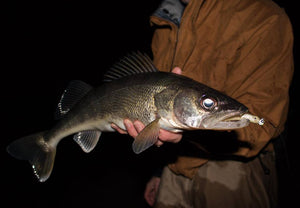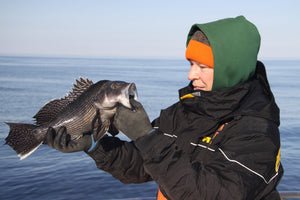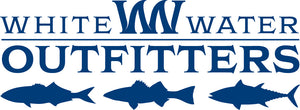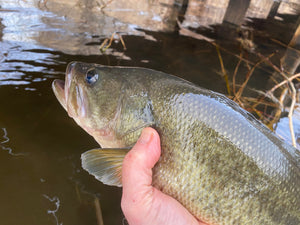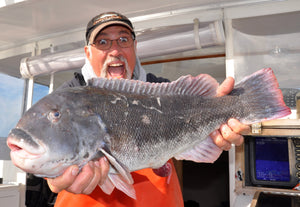Albies In The Suds

For most fall surf fishing fans, false albacore aren’t the primary thought in mind when heading to the beach to target marauding blues or the stripers lurking beneath them. Still the hope for albie pods to start pushing up some spray as they tear through schools of small baitfish remains omnipresent as they scan the horizon for the fast-moving predators. If you are among those watching the calendar and trying to figure out when to arm yourself for the hard tails, plan on mid- to late October being peak season and make sure to pack your albie arsenal before heading to the beach.
Like bluefish, false albacore, (AKA albies, Fat Alberts, hard tails and little tunny) relish making a scene on the surface as they pursue prey with relentless enthusiasm. You can tell them from the choppers by the smaller, tighter pods, less ferocious demeanor, and their habit of always pushing forward at breakneck pace. Another tip-off is that fewer terns and seagulls dive on the albie schools when compared to marauding blues. That's because bluefish slash their prey while false albacore swallow them whole, leaving little behind for the birds to get excited about. Watch carefully and you'll also notice the deeper, football-like shape of the albies as they porpoise on schools of spearing, bay anchovy, sand eels and various rain baits.

Calm Winds, First Light Spark The Bite
As a rule, occasionally ignored, albies prefer to surface feed in fairly calm conditions, often just after dawn or during the late afternoon. They’ll cover plenty of sea in their endless pursuit of baitfish, which is why surfcasters are probably best-off staking out known albie hot spots along the beach with an extra rod rigged specifically for such encounters. Such is the false albacore game that anglers often get in only a few casts before the school slides by, and taking the time to downsize lures from your bluefish and bass standards can cause you to miss your chance.
From a surf point of view, it’s generally best to concentrate efforts along beaches immediately adjacent to an inlet, harbor mouth, or break wall where these speedy predators are routinely drawn into the wash. Cove areas also allow for up-close and personal encounters with albies as they chase terrified baitfish schools down the beach until pocketing them against the shore. In fact, one way to head off false albacore at the pass is to look down the beach and scan for the nearest cove or point. That is where the action is most likely to end up before the albies simply vanish quietly back into the depths.
Get Small
Considering false albacore can top out at 15 pounds or so in our waters, they show a propensity to smack comparatively small offerings. Thus, small and slender tins, epoxy minnows and soft-plastic baitfish imitations offer the best chance at connecting from the surf. In addition to matching the profile of the baitfish false albacore relish, tins and epoxy minnows cast exceptionally well. Burn these back to the beach as quickly as possible and be sure to cast toward where the schools are headed, not where there were a second ago. Opt for the soft-plastics if the albies put on their finicky act or are patrol the beach within easy casting distance.
In terms of specific lures for false albacore, we recommend Tubeless diamond jigs (3/4 to 1.5 oz.), Deadly Dicks (.85 to 1.36 - to 1.75 oz.), Hogy Epoxy Jigs (7/8 to 1-1/4 oz.) and Albie Snax soft plastics. Any of these can be cast with a 6-1/2- to 7-1/2-foot fast-action spinning outfit spooled with 15-pound test mono or 30-lb. braid. A four-foot length of 20-pound test fluorocarbon leader, attached to the main line via a barrel swivel, should precede the lure.

Fly-rodders can get in on this albie surf action with a 9-weight rod and intermediate line the perfect choice. Opt for patterns such as, Enrico Puglisi Ghost Minnows and Bay Anchovies, Epoxy Baitfish "surf candy", or "Albie Wh*re" patterns. Most any light-colored sparsely tied minnow pattern measuring three to four inches that features a splash of silver Mylar or Flashabou. If you need help putting together the perfect albie surf set-up, be it spinning or fly, stop by the shop – we’ve got a few serious albie sharpies on staff.
Parting Shots
If you are lucky enough to draw a smack as an albie school passes through, hold on tight. These fish can really motor. Allow them to take drag and fatigue a bit on their initial runs before putting a little more backbone into the battle. Making sure your drag is set at approximately one-third the breaking strength of your line is a good idea.
When albies strike, they blast off with amazing acceleration and can get into your fly-line backing or a quarter of the way through a spinning spool faster than election year politicians ask for money. Be aware that drag increases significantly as your line stretches out - so starting a little too tight can have terrible ramifications. To lessen the effect of increasing drag pressure on these fish, lower your rod tip toward your quarry to relieve a little bit of the bend from your rod. Bring the rod tip back up to a normal fighting position after those initial runs have slowed and you've made up some line.
As table fare goes, false albacore rank toward the bottom of the list. That being the case, most anglers release them. Because these fish will fight until spent, plan to invest a little time in helping each fully recover before turning it loose. This often means taking several minutes to walk the fish in the wash even while the bite is still underway. So be it. These fish give their all; be sure to return the favor.
- Bryce Poyer


